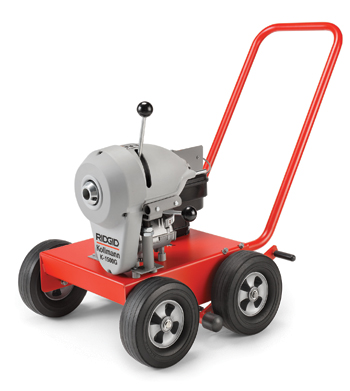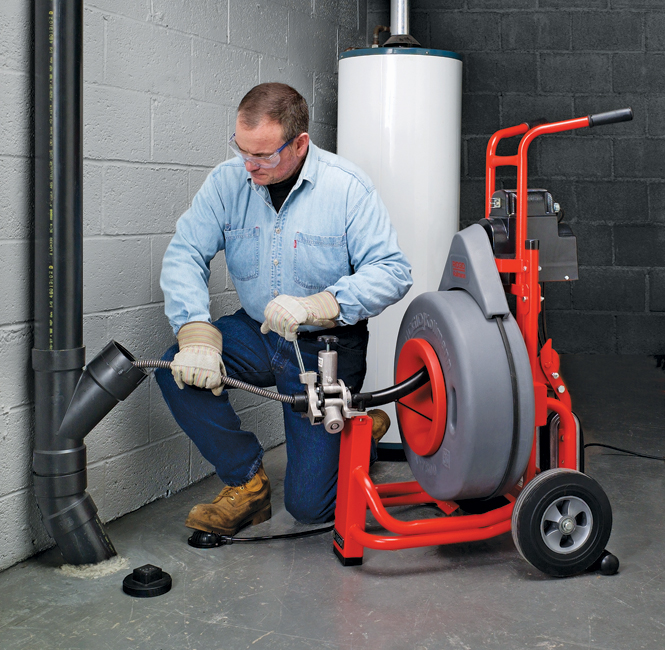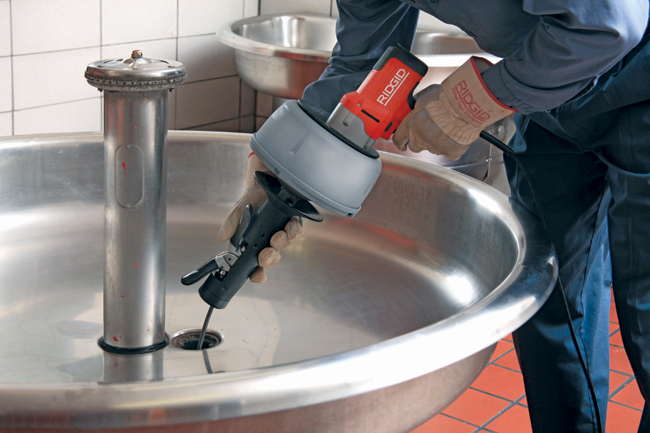Drain Cleaning Dynamos

Sectional vs. Drum Machines
There are two distinctly different kinds of drain cleaning machines sold today, and preferences tend to be regional. Much of the East Coast and Midwest favor sectional drain cleaning machines, in which shorter lengths of cable are joined together and fed through the machine one at a time. The rest of the nation prefers drum machines, which store longer lengths of cable onboard contained in a drum. Tradesmen are traditionalists, so they tend to stick with the equipment they learned on or its latest incarnation.
Demographics aside, each has its practical strengths. With a sectional machine, you don’t have to lug around 100 ft of cable for a 20-ft job. If this seems negligible, it’s not. A 250-lb drum machine includes close to 125 lbs of cable. But with a sectional machine, the cable is stored in external baskets, in 7 ½- to 15-ft lengths, which can be carried in as needed. Sectional cable doesn’t need to be as compact; its more open, flexible cable design helps scour the sides of the drain as you move the cable in and out of the line.
Moreover, if you wear out, break or kink a sectional cable, you’re only out one length. A break or kink in a drum style cable, on the other hand, shortens the entire cable and often makes the repair area less flexible.
Another key difference between sectional machines and drum machines is the rate at which the cable spins. The rotational speed of sectional machines is between 400 to 700 rpm, while drum machines are far less at around 200 rpm. These rotational speeds represent the way in which the machines operate down the drain. Sectional machines cut at higher speeds with low torque transfer. Because of the sectional machine’s high rpm, the operator must use specially designed hand mitts, which have metal staples on the gripping surfaces that can tolerate greater wear. Drum machines tend to rely more on torque transfer to remove a blockage down the line. When using a drum machine, the operator uses leather palmed work gloves that are supplied with the machine.
While drum machines have foot-operated air switches, sectional machines have hand-operated clutch levers. Foot-operated air switches work well because they don’t bring electricity into contact with water and allow for machine and cable control with both hands. The sectional machine’s hand-operated clutch lever allows operators to push down on the lever to engage the cable. Once the lever is released, the cable stops spinning.

Drum machines have cable containment as their primary advantage, often keeping the jobsite and the truck relatively clean. Sectional machines tend to be considered messier because there is more handling of the cable required when transferring the cable from the machine to the carrier.
Drain cleaning machines come in a variety of sizes, from small, hand-operated sink machines to big drain machines with various attachment heads. When shopping for drain machines, consider the environment you will be using them in and the size of the drain. If you do mostly residential work, it makes sense to look for models narrow enough to fit through small doorways and easily down direction-changing stairs. Commercial jobsites tend to have greater access to clean-outs and open work areas so the constraints related to machine choice are not as high.
Auto-Feed Cable Mechanisms
Auto-feed cable mechanisms have been around for a while now, but not every operator wants one. Over time, many have honed their abilities to sense the cable’s resistance and to interpret the motor’s sound as it encounters and works through an obstruction. Plumbers know what that input means, and they’re not willing to trade that knowledge for automation, but they don’t have to.
As an industry, we’ve probably misrepresented the auto-feed’s real value. While auto-feed machines can sometimes plow through blockages unassisted, they’re better used and designed to get to a blockage and back out of the drain with the least amount of physical work on the operator’s part. Most obstructions still require hands on the cable. That’s still the best way to receive feedback on what is happening down the line and to prevent flipping a cable in the drum or breaking it off down the drain. Skill and feedback will always be required in drain cleaning.
An auto-feed reduces the work, which can make a huge difference, in a day or a career. Most plumbers and drain specialists these days send a camera down the line first, then pull it back, then send the cable down, auger through the obstruction, then retrieve the cable back. When they get some flow going, they check it again with a camera. Combined, this could be 1,000 ft of pushing and pulling, and as noted above, 100 ft of cable can weigh 125 lbs. Better to let the machine do the work. Let it open and close, while you step in for the surgery.
There are a variety of auto-feed mechanisms on the market, but most use a lever to engage the cable, typically with several internal bearings. Some models require switching the motor forward to reverse, while others use a lever on the top of the auto-feed that lets you change cable direction on the fly. Move it one direction and it feeds the cable into the drain. Move it the other way and it retrieves the cable back into the drum.
General Safety Precautions
Safety is so important that the precautions deserve repeating at every turn, so here they are: Always wear appropriate safety glasses, gloves, clothing and footwear. Keep your hair short or tied back and always use some form of Ground Fault Circuit Interrupter (GFCI) protection when working in wet conditions, which in this business, is every job. Many machines today come with GFCI protection built into the cords. And when you must use an extension cord, make it a heavy-duty, outdoor-rated cord that is as short as possible, to avoid a substantial voltage drop.

Choosing the right glove for the job is critical enough that reputable manufacturers supply appropriate gloves with their machines. Make sure the gloves you use are in good condition and never use cloth gloves. And it’s important that you wear latex gloves beneath your work gloves to protect against sewer-line pathogens and any acid, lye or other chemicals the customer may have poured down the drain before calling you.
If there are three things to remember when operating a drain cleaner, they are: 1. Know the product you are using, and how to set it up and operate it properly according to the manufacturer’s instructions; 2. Only one person should be operating the drain cleaner at a time — this assures that the operator is in control of both the cable and the machine; and 3. Position the drain cleaning machine as close to the drain opening as possible. The less the cable is exposed outside of the drain, the better you can control the cable and machine.
Other Back Saving Features
Plumbers are known for their lumbar problems. It’s where the years settle first, so manufacturers work hard to limit the back strain associated with moving these machines around. Larger drain cleaning machines are often available with stair climbers, which are metal frames with rubber tracks, like those on refrigeration dollies, which help negotiate stairs. Flip-down loading wheels and lifting hooks help you move a heavy machine off of a truck with less strain, and some machines have parking brakes, which keep the machine from moving back or dancing around when in use. When a machine stays put, you won’t have to reposition it. The little things can make a real difference.
Rob Trefz is the director of pipe installation and maintenance at RIDGID, based in Elyria, Ohio.

Comments are closed here.